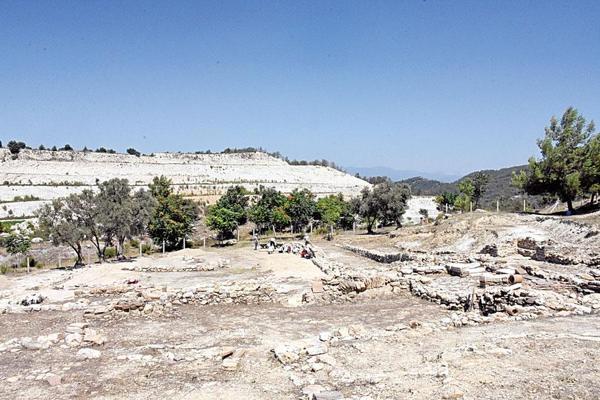Byzantine church found in Muğla’s ‘city of gladiators’
MUĞLA


In the ancient city of Stratonikeia, located in the western province of Muğla’s Yatağan district, an early Byzantine-era church and a mosaic floor dating back to 1,500 years have been unearthed. The ancient city has been known as the city of gladiators. The city’s restoration has recently been completed and it is also home to an Ottoman-era mosque.
Stratonikeia is on the temporary list of the UNESCO World Heritage list and has been home to many civilizations throughout its history. It is also one of the biggest marble cities in the world.
Speaking to state-run Anadolu Agency, the head of the excavations in the ancient city and Pamukkale University Archaeology Department Professor Bilal Söğüt said they had unearthed findings from a 3,500-year-old settlement of in the ancient city.
Söğüt said Stratonikeia had maintained its importance in the Hellenistic, Roman, Byzantine, Anatolian Seljuk, Ottoman, and Republic eras.
“Stratonikeia is a living archaeological city. It is unique. There is no other city where structures have survived since the ancient ages,” he said, adding that they had found considerable artifacts during the works in the ancient city.
They have unearthed remnants of the early-Byzantine era church and the mosaic floor from the Hellenistic, Roman, early Byzantine, middle Byzantine and the Beylics eras in different levels, said the professor.
“We carry out excavations as well as the conservation and the restoration works in various structures of the ancient city. One of these structures is the Erikli Church. The church is positioned nearly 600 meters away from the western walls in the ancient city. It is close to the city and used by people,” he said.
Archaeological and architectural privilege
Söğüt said excavation works were still carried out in the ancient city.
“Beyond its complexity, this structure is also extremely important because its history is known. This place began to be used in the fourth century and completely abandoned in the first quarter of the seventh century. The Erikli church has many privileges in terms of archaeology and architecture. We clean the space, which has different floors such as stone, brick or mosaic. I hope we will see how this place was originally when the work is done,” he said.
The professor said the entrance to the church and the areas where the entrance is connected are stone-paved and in particular, the main seraglio part and the columns are of very good quality.
“Erikli church is one of the places where people have donated the most during the early Byzantine period,” said Söğüt, pointing out that high quality workmanship was used in the unearthed structures of the church.
“There are a lot of materials here, but we have also identified candlesticks with cruciform hangers and prayer-like statements on them. Moreover, we have found bowls brought from northern Africa and used here. We have unearthed a lot of data related to both the religious and social life of the early Byzantine era,” he said.
Söğüt said the unearthed structures in the ancient city would be presented to visitors with 3D technology.
